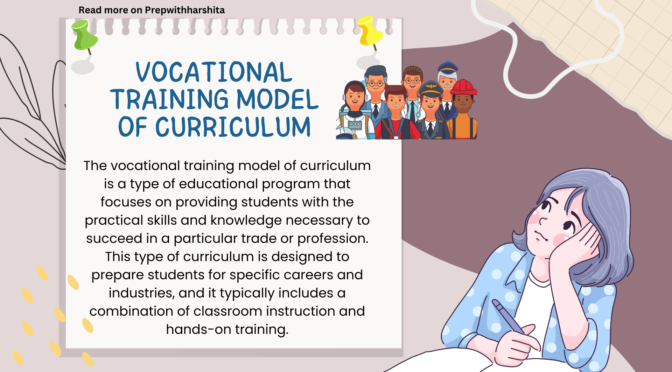The vocational training model of curriculum is a type of educational program. It focuses on providing students with practical skills and knowledge.
This type of curriculum is designed to prepare students for specific careers and industries. It typically includes a combination of classroom instruction and hands-on training.
Speciality of Vocational Training Model
The vocational training model of curriculum often emphasizes real-world experience and practical skills over theoretical knowledge.
Students may learn by working with tools and equipment, practicing specific techniques, and completing projects that simulate real-world situations.
This type of education can be particularly useful for students who want to enter fields such as automotive repair, construction, cosmetology, culinary arts, healthcare, and many others.
In addition to technical skills, vocational training may also include courses on business management, customer service, communication, and other soft skills. These Skills are essential for success in the workplace.
Some vocational programs may also offer job placement services or internships that allow students to gain valuable work experience while still in school.
Overall, the vocational training model of curriculum is designed to help students develop the specific skills and knowledge they need to enter the workforce .
Also Visit: Prep with Harshita
Features of Vocational training Model of Curriculum Development
- Focus on practical skills: The focus of vocational training is to provide students with the practical skills and knowledge required. This may include hands-on training, practice with tools and equipment, and simulated real-world situations.
- Career-oriented: It is career-oriented, with a focus on preparing students for specific careers and industries. The curriculum is designed in collaboration with employers and industry experts to ensure that graduates have the skills and knowledge needed
- Flexible: Vocational training programs are more flexible than traditional academic programs. These programs are shorter program durations and give more opportunities for part-time or evening study. This makes it easier for students to balance their education with work and other responsibilities.
- Emphasis on soft skills: Vocational training programs emphasize soft skills such as communication, teamwork, and problem-solving. These skills are essential for success in the workplace.
- Job placement services: Many vocational training programs offer job placement services or internships. These internships help students gain valuable work experience and connect with potential employers.
It is a career-oriented, flexible, and practical approach to education that prepares students for specific careers and industries.



One thought on “Vocational Training Model of Curriculum”